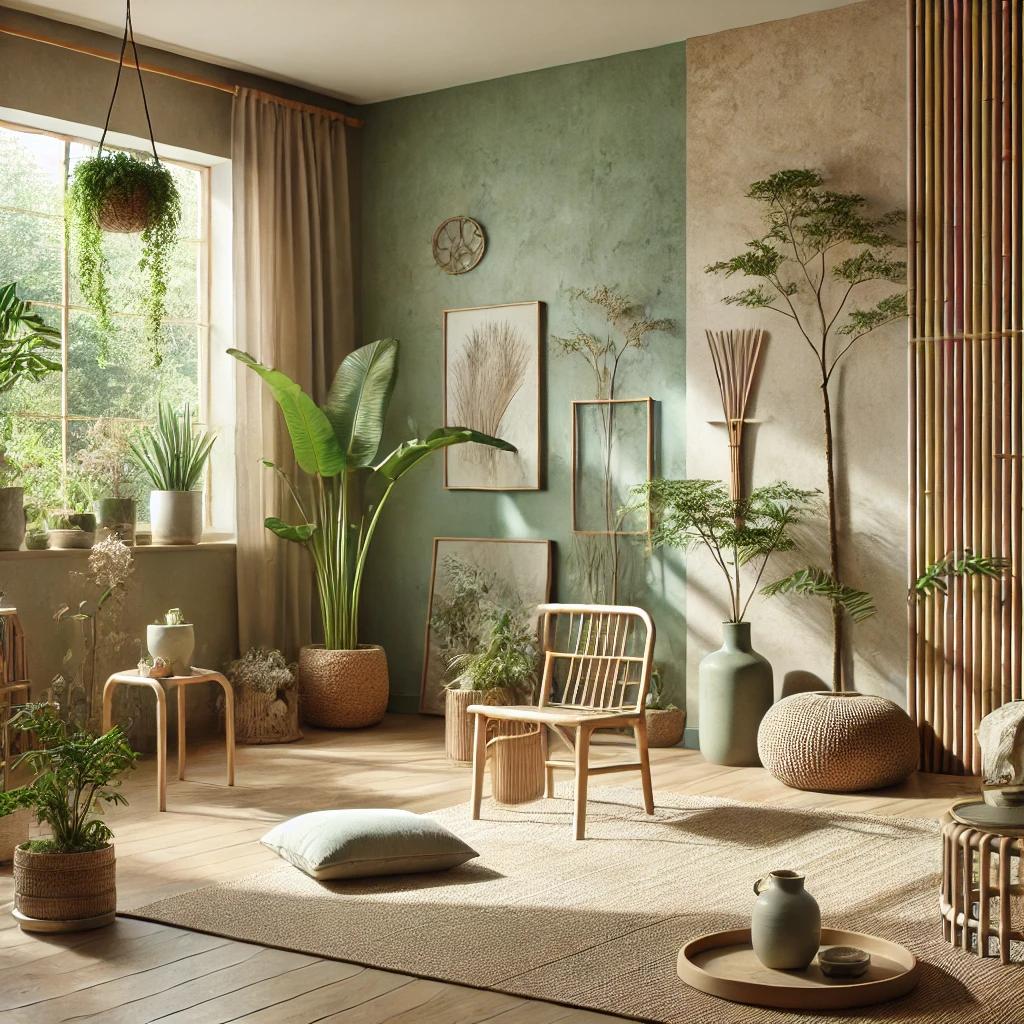In today’s fast-paced world, biophilic design is gaining popularity for its ability to connect homeowners with nature, creating spaces that are both beautiful and calming. By integrating natural materials, colors, and elements, biophilic design promotes well-being and reduces stress. Here’s how you can bring the outdoors into your home using this holistic design approach.
1. Choose a Nature-Inspired Color Palette
The first step to biophilic design is incorporating colors found in nature. Think earthy tones, greens, browns, and shades of blue.
Color Palette Tips:
- Greens: Sage, moss, and olive evoke a sense of growth and vitality.
- Blues: Soft sky blue or deep ocean tones promote calmness.
- Earthy hues: Terracotta, beige, and warm browns create grounding warmth.
Pro Tip: Choose accent walls or soft furnishings in nature-inspired colors to enhance the theme.
2. Integrate Natural Materials
Natural materials are key to achieving a biophilic design. Incorporate wood, stone, bamboo, and natural textiles wherever possible.
Material Ideas:
- Wood flooring and paneling: Adds warmth and texture.
- Stone accents: Use in kitchen backsplashes, fireplaces, or bathroom walls.
- Rattan or wicker furniture: Offers a rustic and earthy feel.
Sustainable Option: Opt for reclaimed or sustainably sourced materials to keep your design eco-friendly.
3. Maximize Natural Light
Natural light is a core component of biophilic design. It helps regulate circadian rhythms and improves mood.
How to Increase Natural Light:
- Use large windows and glass doors to bring in more light.
- Install sheer or light-filtering curtains instead of heavy drapes.
- Consider skylights for rooms with limited windows.
Pro Tip: Position mirrors strategically to reflect and amplify natural light throughout the space.
4. Bring in Indoor Plants
Plants are essential for creating a connection to nature. They purify the air, boost productivity, and add life to any room.
Best Plants for Biophilic Design:
- Snake plant: Low maintenance and excellent air purifier.
- Fiddle leaf fig: Perfect for large spaces.
- Spider plant: Great for hanging baskets and shelves.
Pro Tip: Group plants at different heights and sizes for a layered, natural look.
5. Incorporate Water Elements
Water features enhance the soothing and refreshing qualities of biophilic design.
Water Feature Ideas:
- Small indoor fountains or tabletop waterfalls.
- Aquariums with calming aquatic life.
- Reflecting pools or ponds if you have outdoor access.
Benefit: The sound of flowing water can help reduce stress and improve focus.
6. Use Organic Shapes and Patterns
Nature rarely follows straight lines, so embrace organic, free-flowing shapes and patterns in your decor.
Ways to Incorporate Organic Design:
- Furniture with curved edges instead of sharp lines.
- Wallpapers with botanical or leaf patterns.
- Decorative pieces inspired by natural forms like seashells or flowers.
7. Create Visual Connections to Nature
Even if you live in an urban environment, visual connections to nature can have a positive impact.
Tips for Visual Access:
- Position furniture to face windows with outdoor views.
- Add nature-themed artwork or photographs.
- Install glass partitions to open up spaces and enhance outdoor visibility.
8. Improve Airflow and Ventilation
Clean, fresh air is crucial for both comfort and health. Ensure proper airflow to maximize the benefits of biophilic design.
How to Improve Ventilation:
- Open windows frequently to allow cross-ventilation.
- Use air purifiers and ceiling fans for consistent airflow.
- Incorporate operable skylights for fresh air circulation.
9. Add Natural Textures and Layers
Texture is essential in biophilic design because it engages the senses and mimics the natural environment.
How to Add Texture:
- Layer rugs made from natural fibers like jute or sisal.
- Use textured throw pillows and blankets.
- Combine smooth stone surfaces with rough wooden accents.
Pro Tip: Mixing textures adds depth and makes spaces feel more inviting.
10. Incorporate Natural Lighting Fixtures
Choose lighting fixtures that evoke a natural aesthetic or are made from eco-friendly materials.
Lighting Ideas:
- Bamboo pendant lights or woven rattan lamps.
- Fixtures designed to mimic sunlight, such as full-spectrum LED lights.
- Candles or lanterns for a cozy, natural glow.
Final Thoughts
Biophilic design is about more than just decor—it’s a way to foster harmony between your living space and the natural world. By incorporating natural materials, plants, and organic elements, you can create a peaceful, rejuvenating home that nurtures both body and mind.
Want help integrating biophilic design into your home? Contact Perfecting Paint for expert advice and eco-friendly painting services.
Request a free estimate and bring nature indoors today!

